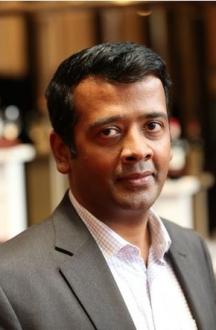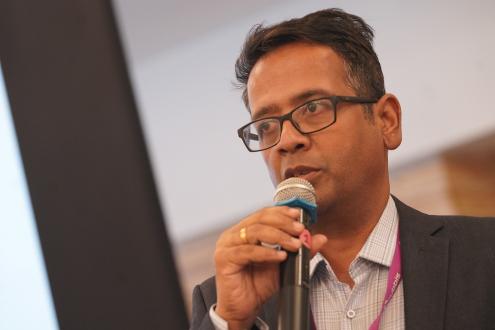Infosys-Finacle expert Abhra Roy on Leveraging Technology to Unlock Wealth Management Success

Sep 15, 2023
Abhra Roy is Head of Finacle Wealth Management, which is part of Infosys Finacle, one of the sponsors of the Hubbis Wealth Management Forum in Mumbai on August 31. Roy offered delegates an informative and lively presentation at the event, supported by a comprehensive and easy-to-navigate slide show. His key messages were that technology is empowering the wealth industry, opening the door to optimised client outcomes and an elevated customer experience, while at the same time helping make RMs and advisors far more efficient, productive and client-centric. He advised building digital solutions in a modular fashion with agility and avoiding the pitfalls of one apparent solution that might not be adaptable to future innovations.
Roy is responsible for managing the Finacle Wealth Management product line for Infosys Finacle, and also for charting its product strategy; this includes the management and development of the Wealth Management product line, managing client relationships with banks and financial institutions, and working on the detailed product road map.
Specialising in wealth management
He specialises in digital solutions for Private Wealth Management, Financial Advisory, Brokerage Operations, as well as Custodial and Depository operations. He is quite an authority, having published several thought leadership papers on the role of technology in the Wealth Management space.
Abhra has been a regular at our Hubbis events and has been working hard to develop the firm’s presence in India. His and his team’s efforts have met with considerable success, as they already count leading banking names such as Axis Bank, DBS Bank and HFDC as customers in India, and more recently have begun working with another large Tier 1 Private sector Bank.
The firm also works closely with some of the most prominent digital transformation leaders in the region’s banking world, such as DBS. Moreover, they have more than 30 global technology installations at banks in 17 countries, delivering a complete front-to-back investment platform replete with additional modular solutions.
High demand and an eager market
Roy opened his talk by acknowledging the intense competition in the technology space, and also the strong demand and rapid adoption of solutions amongst clients in Asia. He observed that the wealth management industry in the region is growing apace and maturing rapidly, but that there is far more development ahead.
He pointed to fast-rising private wealth, a more discerning customer base and also the huge inter-generational wealth transfer in the region, with so much of that vast sea of money flowing to digitally savvy or digital native private clients. He highlighted the ongoing expansion and evolution of regulation, and the rise of RegTech firms with solutions to help with the huge challenges around compliance.
Democratising advice and access
The democratisation of access to investment products and also to levels of advice is another advance taking place, he observed, for example with mass affluent clients able to buy into products previously the preserve of HNWIs and HNW clients able to buy into assets that might before have only been accessible to UHNWIs.
All of these developments are being enabled and fast-tracked by technology, resulting in what he called a lot of ‘re-platforming’ to diversify and scale the wealth offerings.
Evolving the wealth journey
Roy explained that they look at technology evolution from four aspects. Digital advisory tools help provide superior client interaction in what he called the ‘age of collaboration’. Smart data and smart experiences harness data for hyper-personalised customer journeys. There is an ongoing transition from transactions to conversations under the banner ‘conversational investments’. And all this must be achieved with the latest technology that is decoupled, composable, and ‘Cloud’ native.
He pointed to research from both BCG and Accenture, which highlight several key points. First, the trends are going to change rapidly in the investment advisory space with investment advisory driving the next wave of innovation. Second, hyper-personalisation and better user experiences are the directions of the future.
The hybrid age
Roy referred back to the pandemic, during which there was a dramatic upscaling and acceleration of digital solutions adoption, and at the same time, the hybrid advisory model blossomed, combining human and digital interaction between wealth management providers and the client base.
“But how do you embed this within your applications so that when your RM or the advisor is using a workbench, you can have the video call, co-browse with the clients, and follow up properly?” he pondered.
Strategic steps
He then offered some key digital solutions for boosting this type of engagement so that there is a very easy rapport achieved digitally between the various parties, all leading hopefully to more tailored and curated investment decisions and better allocation within the portfolios. This evolution best suits the higher segments of wealth more than the mass affluent market, but the advances are valuable for the entire wealth market.
Into the future…
Roy turned his attention to hyper-personalisation and AI. “There is much talk about how this is going to shape up, and certainly, the wealth management industry is still at a nascent stage of understanding and adoption,” he said. “You are looking at going beyond the traditional models of data collection, including capturing all structured and unstructured data in your application and then driving analytics from all that.”
He said this data could capture spending habits, it could also scrape data from social media handles, it could include individual goals and cash flows, and analyse banking statements, all, he added, with due respect to privacy laws.
“You can end up with a very sophisticated and complex data model that truly helps you enhance the client portfolios,” he explained. “This would never be possible without this technology; it would take thousands of man-hours and not even achieve a good result.”
Reeling off the list of advantages of hyper-personalisation, Roy highlighted the enhanced customer experience, improved engagement, high or higher client conversion rates, better financial decision-making, improved trust, optimised portfolio management, data-driven insights and greater efficiency and automation.
Win-win scenarios but you must invest smart
Roy said that with so many advantages all round at stake, - for the clients for the RMs, for the banks or wealth firms, it is vital for the wealth institution to achieve these goals by investing wisely in the right technology and planning strategically ahead.
He then drilled down into how to build the solutions, noting that it is valuable to consider these technology solutions in three distinct layers. Customers can build solid business engines which serve the back office and branch operations, then build digital experiences and layers on top.
“This is layered technology architecture because you need to bring in the best of breed at each layer,” he explained. “You can mix and match and build from the whole technology provider ecosystem, instead of getting stuck with one solution provider.”
Summarising, he said this composable architecture is cloud-native, involves self-contained components, is receptive to APIs, accommodates event-driven changes, includes data lakes and embedded analytics, is scalable, configurable and extendable, as well as being deployed continuously.
Event Driven Keeping flexible, staying agile
He cautioned that going just with one provider significantly limits flexibility and future agility. “The single provider is probably giving you a very tightly coupled application which you won’t be able to decouple in the future,” he commented. “That is why the layered approach is optimal.”
He then added commentary on why the technology must be cloud-native, this being a primary requirement of all the banks they work with today. If it is not cloud-native, he warned the technology cannot be built out at scale but adding that a very close eye must also be focused on privacy and cyber-security.
Collaborative wealth management
He drew his talk towards a close by pointing to how technology is making it easier to conduct investment activity including reporting and portfolio analysis over chat apps such as WhatsApp, even for the affluent segments as well as the mass affluent market. He offered delegates a short video to underline his point.
“These types of innovations are really changing the way the entire investment world is looking at technology and embracing change,” he concluded. “Collaborative decision-making is very important as conversations involve clients in investment decisions, and informed discussions empower clients to make better investment choices.

Senior Product Line Manager and Head, Finacle Wealth Management at Infosys Finacle






